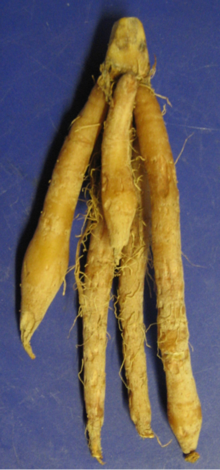Chinese ginger
| Chinese ginger | ||||||||||||
|---|---|---|---|---|---|---|---|---|---|---|---|---|

Chinese ginger ( Boesenbergia rotunda ) |
||||||||||||
| Systematics | ||||||||||||
|
||||||||||||
| Scientific name | ||||||||||||
| Boesenbergia rotunda | ||||||||||||
| ( L. ) Mansf. |
As fingerroot ( Boesenbergia rotunda ) is a flowering plant in the family of the ginger family referred (Zingiberaceae). The rhizome is used as a medicinal plant in China and as a spice on the Southeast Asian peninsula ; because of its shape, the spice is also called fingerroot . It is one of four ginger-like plants that are sometimes referred to as galangal.
description
Vegetative characteristics
Boesenbergia rotunda is a perennial herbaceous plant that reaches heights of up to 50 centimeters. A bright yellow rhizome is formed as a persistence organ, which is oval-shaped, very aromatic and robust. It forms three to four leaves , which are divided into leaf sheath, petiole and leaf blade. The channel-shaped petiole is 7 to 16 inches long. The leaf sheath is red. The ligula has two columns and is about five millimeters long. The simple leaf blade is ovoid-elongated or elliptical-lanceolate with a rounded to wedge-shaped blade base and a pointed upper end with a length of 25 to 50 centimeters and a width of 7 to 12 centimeters. The leaves are bare except for a few trichomes on the central vein of the underside of the leaf.
Generative characteristics
The flowering period in China extends from July to August. The inflorescences are at the end of 3 to 7 centimeters long false stems, which consist of almost perched in the leaf sheaths. The bracts are lanceolate with a length of 4 to 5 centimeters.
The fragrant, hermaphrodite flowers are zygomorphic and threefold. The chalice is two-columned with a length of 1.5 to 2 centimeters. The pink crown consists of a 4.5 to 5.5 centimeter long corolla tube and 1.5 to 2 centimeters long, elongated corolla lobes. The lateral staminodes are light pink and obovate with a length of about 1.5 centimeters. The 2.5 to 3.5 cm large labellum is white or pink with purple stripes, violin-shaped, concave, slightly curled at the edge, with entire margins towards the tip. The stamens are relatively short with a length of 1 to 3 millimeters and the connective appendages are bent back, with two columns.
The number of chromosomes is 2n = 36.
Occurrence
Boesenbergia rotunda is widespread in India , Indonesia , Malaysia and Sri Lanka and originally thrives in China only in Xishuangbanna Dai Zu Zizhizhou in southern Yunnan in dense forests at altitudes of around 1000 meters. Chinese ginger is cultivated throughout the Indo-Chinese region.
Taxonomy
The first publication took place in 1753 under the name ( Basionym ) Curcuma rotunda by Carl von Linné in Species Plantarum , p. 2. The new combination to Boesenbergia rotunda (L.) Mansf. was published in 1958 by Rudolf Mansfeld in Kulturpflanze , Volume 6, p. 239. Further synonyms for Boesenbergia rotunda (L.) Mansf. are: Boesenbergia pandurata (Roxb.) Schltr. , Boesenbergia cochinchinensis (Gagnep.) Loes. , Gastrochilus rotundus (L.) Alston , Gastrochilus panduratus (Roxb.) Ridl. , Kaempferia pandurata Roxb. , Kaempferia cochinchinensis Gagnep. , Kaempferia ovata Roscoe .
use
Chinese ginger is particularly popular in Thai cuisine . Under the name krachai ( กระชาย ), the fresh rhizome is ground into a paste together with other spices or cooked in the form of thin slices in stews.
Hazards and protective measures
Boesenbergia rotunda is used intensively in its cultivated as well as its wild form. Since this has so far only had a minor impact on the wild population of this species and it also occurs in protected areas, it has been rated by the IUCN as "Least Concern" = "low risk" since 2009.
swell
- Delin Wu, Kai Larsen: Zingiberaceae. : Boesenbergia rotunda , p. 367 - the same text online as the printed work , In: Wu Zheng-yi, Peter H. Raven (Ed.): Flora of China. Volume 24: Flagellariaceae through Marantaceae , Science Press and Missouri Botanical Garden Press, Beijing and St. Louis, 2000, ISBN 0-915279-83-5 .
Individual evidence
- ↑ a b c d e Delin Wu, Kai Larsen: Zingiberaceae. : Boesenbergia rotunda , p. 367 - the same text online as the printed work , In: Wu Zheng-yi, Peter H. Raven (Ed.): Flora of China. Volume 24: Flagellariaceae through Marantaceae , Science Press and Missouri Botanical Garden Press, Beijing and St. Louis, 2000, ISBN 0-915279-83-5 . Boesenbergia (PDF; 43 kB).
- ↑ Boesenbergia rotunda at Tropicos.org. In: IPCN Chromosome Reports . Missouri Botanical Garden, St. Louis
- ↑ Rafaël Govaerts (Ed.): Boesenbergia rotunda. In: World Checklist of Selected Plant Families (WCSP) - The Board of Trustees of the Royal Botanic Gardens, Kew . Accessed December 31, 2016.
- ↑ Boesenbergia rotunda in the IUCN Red List of Threatened Species 2013.2. Posted by: S. Contu, 2009. Retrieved May 14, 2014 ..

